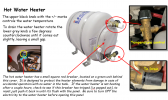S. Todd
Well-known member
- Joined
- Jan 27, 2015
- Messages
- 720
- Fluid Motion Model
- R-29 S
- Hull Identification Number
- FMLT2916J021
- Non-Fluid Motion Model
- Innova & Paddle North kayaks
- Vessel Name
- Audrey Rose
- MMSI Number
- 368196550
I do not like to drain the hot water tank into the bilge in our 2021 R29 because it is difficult to get the water out of there (boat sits bow down on its trailer). Therefore, what I do is: disconnect the water line coming out of the freshwater pump that feeds the water heater and the rest of the boat and suck the water out of that line with a 12-gallon shop vacuum. If you open the faucets so air can enter the water heater you can suck almost all the water from the water heater and the lines. After drawing out all the water that way, I take the extra step to run non-toxic antifreeze through the entire systems, just in case there is water left somewhere in the system. (It gets cold in northern Michigan, and I don't want to risk any freeze damage.)
Because the boat sits on a trailer, I also go around the outside of the hull with the shop vacuum and draw any leftover antifreeze or water from the through hull fittings. This deals with any potential water in the check valves from the bilge pumps and stops the drips on the garage floor.
Because the boat sits on a trailer, I also go around the outside of the hull with the shop vacuum and draw any leftover antifreeze or water from the through hull fittings. This deals with any potential water in the check valves from the bilge pumps and stops the drips on the garage floor.

